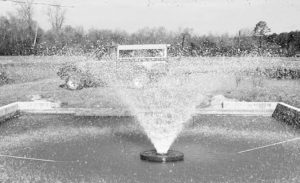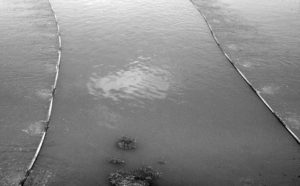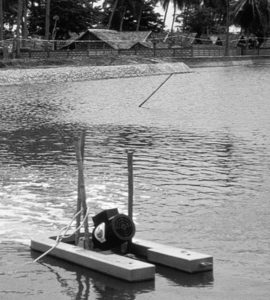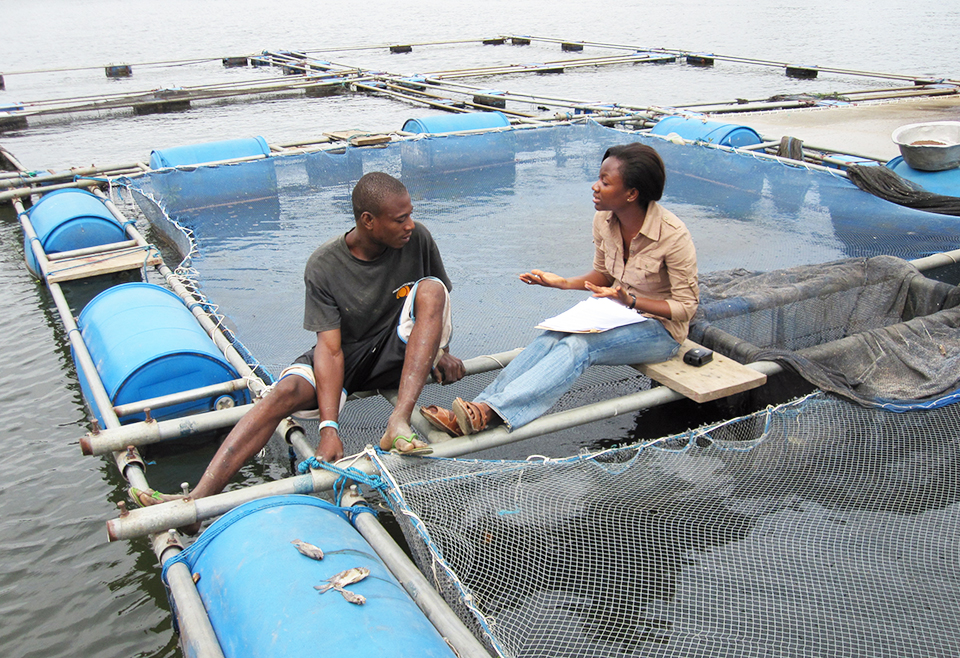Aeration prevents low DO, aids feed efficiency, increases production

Productivity increases in aquaculture ponds in response to nutrient inputs of fertilizer and feed. These inputs, however, increase the demand for oxygen by organisms, and low concentrations of dissolved oxygen can occur in pond water.
Usually, low dissolved-oxygen concentrations occur during early morning hours, but also result from phytoplankton dieoffs and cloudy weather. Most species of fish and shrimp are stressed by dissolved-oxygen concentrations below 3 or 4 milligrams per liter. In ponds with consistently low concentrations, culture organisms usually have diminished appetites, greater susceptibility to disease and higher mortality. Feed-conversion efficiency and production accordingly suffer.
Mechanical aeration is used widely in pond aquaculture to prevent low dissolved-oxygen concentrations, especially at night; improve the efficiency of feed use; and increase production of the culture species.
Dissolved oxygen
The capacity of water to dissolve oxygen depends upon atmospheric pressure, oxygen percentage in the air, water temperature, and salinity. Representative concentrations of dissolved oxygen at saturation in waters of different salinities and temperatures are provided in Table 1.
Boyd, Solubility of dissolved oxygen, Table 1
| Temperature (° C) | Salinity (ppt) 0 | Salinity (ppt) 10 | Salinity (ppt) 20 | Salinity (ppt) 30 | Salinity (ppt) 40 |
|---|
Temperature (° C) | Salinity (ppt) 0 | Salinity (ppt) 10 | Salinity (ppt) 20 | Salinity (ppt) 30 | Salinity (ppt) 40 |
|---|---|---|---|---|---|
| 10 | 11.28 | 10.58 | 9.93 | 9.32 | 8.75 |
| 15 | 10.07 | 9.47 | 8.91 | 8.38 | 7.88 |
| 20 | 9.08 | 8.56 | 8.06 | 7.60 | 7.17 |
| 25 | 8.24 | 7.79 | 7.36 | 6.95 | 6.56 |
| 30 | 7.54 | 7.14 | 6.75 | 6.39 | 6.05 |
| 35 | 6.93 | 6.58 | 6.24 | 5.91 | 5.61 |
The tabular values of dissolved oxygen are for water in contact with the atmosphere at 760 mm mercury, normal barometric pressure at sea level. The saturation concentration of dissolved oxygen (DO) for any other barometric pressure is estimated as follows:

For example, if the water temperature is 25 degrees C, salinity is 10 ppt, and barometric pressure is 735 mm Hg, the dissolved-oxygen concentration at saturation is:

Barometric pressure changes continuously, but these changes are minor. The main factor causing differences in barometric pressure is elevation. Barometric pressure declines with increasing elevation (Table 2).
Boyd, Barometric pressure, Table 2
| Elevation (m) | Barometric Pressure (mm Hg) | Elevation (m) | Barometric Pressure (mm Hg) |
|---|
Elevation (m) | Barometric Pressure (mm Hg) | Elevation (m) | Barometric Pressure (mm Hg) |
|---|---|---|---|
| 0 | 760 | 1,250 | 657 |
| 250 | 738 | 1,500 | 638 |
| 500 | 717 | 1,750 | 620 |
| 750 | 696 | 2,000 | 602 |
| 1,000 | 676 | 2,250 | 585 |
Dissolved oxygen diffuses between air and water in response to oxygen pressure. The oxygen pressure is roughly 21 percent of barometric pressure because 20.95 percent of normal air is oxygen. The oxygen pressures in air and water are equal when water is saturated with dissolved oxygen.
During daytime, pond water often has a dissolved-oxygen concentration greater than saturation because of oxygen released by the photosynthesis of phytoplankton. In this situation, known as supersaturation, oxygen diffuses from the water to the air because the pressure of oxygen in water is greater than in air.
At night, when photosynthesis stops, respiration continues and dissolved-oxygen concentrations often fall below saturation. Nevertheless, the diffusion of oxygen into the water seldom is fast enough to prevent dissolved-oxygen concentrations from steadily declining in unaerated aquaculture ponds at night.
Mechanical aerators

Mechanical aerators increase the rate at which oxygen from air enters water by providing a greater surface area between the air and water to facilitate diffusion. This can be achieved mechanically by two methods.
Water can be splashed into air to increase its surface area and accelerate the rate of diffusion. Alternatively, bubbles of air released into water create a large surface area between the bubbles and water through which oxygen from the bubbles enters the water. Both “splasher” and “bubbler” aerators can be effective.
It is important to note that aerators are most effective when dissolved-oxygen concentrations in water are very low, for the driving force causing oxygen to enter the water is the difference in pressure between the oxygen in the air and the oxygen in the water. Moreover, when water is supersaturated with dissolved oxygen, most aerators transfer oxygen from water to air as deoxygenators.
Water circulation

In addition to transferring oxygen to water, aerators circulate pond water. Water circulation is beneficial in moving oxygenated water away from aerators to prevent localized saturation and loss of oxygen-transfer efficiency. It prevents ponds from thermally stratifying. Aerator-induced water currents transport oxygen throughout the pond for use by the culture species.
Circulation creates ripples on the water surface that favor the outward diffusion of ammonia and other toxic gases. It also delivers water containing dissolved oxygen over pond bottoms to avoid localized pockets of anaerobic sediment.
In intensive ponds, aeration is necessary during daytime to provide circulation even though little or no oxygen transfer results. However, the amount of aeration applied usually should be reduced during daytime to minimize oxygen loss to the air and lessen energy costs. At night, aeration should be increased to prevent low dissolved-oxygen concentrations.
Aerator types
There are many kinds of mechanical aerators. The most common types of splasher aerators are paddlewheel aerators and vertical turbine aerators. One type of bubbler aerator is the diffused-air aeration system, which releases bubbles of air near pond bottoms to rise through the water column. Another type is the propeller-aspirator-pump aerator, which releases tiny air bubbles into turbulent water created by a rapidly rotating impeller.
Aeration efficiency
Mechanical aerators are subjected to oxygen-transfer tests, and manufacturers often report standard aeration efficiency (SAE) values for their aerators. SAE is the quantity of oxygen an aerator will transfer per horsepower in one hour. Typical SAE values for aerators used in aquaculture range 1 to 2 kg oxygen per horsepower per hour.
SAE is measured for 20 degrees-C, 0 milligrams per liter dissolved oxygen and clear tap water. During operation in a pond containing 3 to 4 milligrams per liter dissolved oxygen, the actual oxygen-transfer rate will be 40 to 50 percent of the SAE given by the manufacturer or vendor.
Aeration and production

There have been few careful studies of the increase in fish and shrimp production that can be expected per horsepower of aeration. Nevertheless, experience and calculations based on pond oxygen budgets suggest that production can be increased by about 400 kg for each horsepower of aeration applied.
For example, suppose 1,500 kilograms per hectare can be produced without mechanical aeration. To increase production by 3,500 kg to 5,000 kilogram per hectare, the minimum aeration requirement is about 9 horsepower per hectare (3,500 kilogram per hectare 400 kilograms per liter), but to be safe, probably no less than 1.5 times the minimum, 14 horsepower per hectare, should be used.
Aerator positioning
Few studies have examined the best ways of positioning aerators in ponds. Fish move to aerated zones, so positioning is less important in fish ponds than shrimp ponds. In fact, in channel catfish farming, all aerators often are located in one end of the pond. This practice allows the use of a single electrical service panel and greatly reduces the amount of electrical wire between the panel and aerators.
In shrimp ponds, the long-standing practice of positioning aerators to create a circular movement of water is probably as good as any other alternative. To avoid erosion, aerators should not be mounted in water less than 0.75 meters deep or near embankments. Water currents also should not impinge on embankments for the same reason. Moreover, water currents from one aerator should not collide with currents from another.
Safety considerations
Aerators are dangerous pieces of equipment because they are electrically powered and operate in water. They also have rapidly rotating parts. Workers should be carefully trained about aerator use and electrical safety to avoid accidents. No one should closely approach an operating aerator by wading or in a small boat.
(Editor’s Note: This article was originally published in the August 2004 print edition of the Global Aquaculture Advocate.)
Now that you've reached the end of the article ...
… please consider supporting GSA’s mission to advance responsible seafood practices through education, advocacy and third-party assurances. The Advocate aims to document the evolution of responsible seafood practices and share the expansive knowledge of our vast network of contributors.
By becoming a Global Seafood Alliance member, you’re ensuring that all of the pre-competitive work we do through member benefits, resources and events can continue. Individual membership costs just $50 a year.
Not a GSA member? Join us.
Author
-

Claude E. Boyd, Ph.D.
Department of Fisheries and Allied Aquacultures
Auburn University
Alabama 36849 USA
Tagged With
Related Posts

Health & Welfare
10 paths to low productivity and profitability with tilapia in sub-Saharan Africa
Tilapia culture in sub-Saharan Africa suffers from low productivity and profitability. A comprehensive management approach is needed to address the root causes.

Health & Welfare
A look at tilapia aquaculture in Ghana
Aquaculture in Ghana has overcome its historic fits and starts and is helping to narrow the gap between domestic seafood production and consumption. Production is based on Nile tilapia.

Health & Welfare
A holistic management approach to EMS
Early Mortality Syndrome has devastated farmed shrimp in Asia and Latin America. With better understanding of the pathogen and the development and improvement of novel strategies, shrimp farmers are now able to better manage the disease.

Responsibility
A look at various intensive shrimp farming systems in Asia
The impact of diseases led some Asian shrimp farming countries to develop biofloc and recirculation aquaculture system (RAS) production technologies. Treating incoming water for culture operations and wastewater treatment are biosecurity measures for disease prevention and control.

